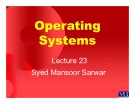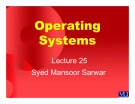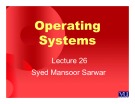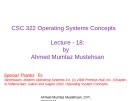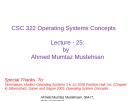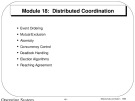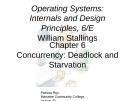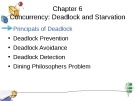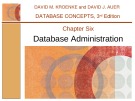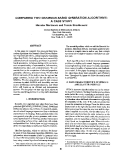
The Deadlock Problem
-
Lecture Operating systems: Lesson 22 - Dr. Syed Mansoor Sarwar. The main topics covered in this lesson include: semaphores based solutions for the critical section problem, deadlock and starvation, binary and counting semaphores, synchronization tool, n-processes critical section problem,...
 15p
15p  youzhangjing_1909
youzhangjing_1909
 28-04-2022
28-04-2022
 16
16
 4
4
 Download
Download
-
Lecture Operating systems: Lesson 23 - Dr. Syed Mansoor Sarwar. The main topics covered in this lesson include: busy waiting, new definition of semaphore, process synchronization, deadlock and starvation, binary and counting semaphores, semaphore implementation, problems with semaphores,...
 24p
24p  youzhangjing_1909
youzhangjing_1909
 28-04-2022
28-04-2022
 13
13
 3
3
 Download
Download
-
Lecture Operating systems: Lesson 25 - Dr. Syed Mansoor Sarwar. The main topics covered in this lesson include: dining philosophers problem, high-level synchronization constructs, critical region, monitor, possibility of deadlock, the region statement, monitors with condition variables,...
 34p
34p  youzhangjing_1909
youzhangjing_1909
 28-04-2022
28-04-2022
 12
12
 3
3
 Download
Download
-
Lecture Operating systems: Lesson 26 - Dr. Syed Mansoor Sarwar. The main topics covered in this lesson include: monitors—dining philosophers, the deadlock problem, deadlock characterization, deadlock handling, deadlock prevention, bridge crossing example, system model, resource allocation graph,...
 27p
27p  youzhangjing_1909
youzhangjing_1909
 28-04-2022
28-04-2022
 16
16
 3
3
 Download
Download
-
The objectives of this chapter: To develop a description of deadlocks, which prevent sets of concurrent processes from completing their tasks; To present a number of different methods for preventing or avoiding deadlocks in a computer system.
 44p
44p  caphesuadathemot
caphesuadathemot
 20-12-2021
20-12-2021
 18
18
 7
7
 Download
Download
-
Chapter 17 examines various mechanisms for process synchronization and communication, as well as methods for dealing with the deadlock problem, in a distributed environment. In addition, since a distributed system may suffer from a variety of failures that are not encountered in a centralized system, we also discuss here the issue of failure in a distributed system.
 40p
40p  koxih_kothogmih3
koxih_kothogmih3
 24-08-2020
24-08-2020
 17
17
 5
5
 Download
Download
-
This chapter examines two problems that plague all efforts to support concurrent processing: deadlock and starvation. We begin with a discussion of the underlying principles of deadlock and the related problem of starvation. Then we examine the three common approaches to dealing with deadlock: prevention, detection, and avoidance.
 35p
35p  koxih_kothogmih3
koxih_kothogmih3
 24-08-2020
24-08-2020
 18
18
 4
4
 Download
Download
-
This chapter examines two problems that plague all efforts to support concurrent processing: deadlock and starvation. We begin with a discussion of the underlying principles of deadlock and the related problem of starvation. Then we examine the three common approaches to dealing with deadlock: prevention, detection, and avoidance.
 23p
23p  koxih_kothogmih3
koxih_kothogmih3
 24-08-2020
24-08-2020
 14
14
 3
3
 Download
Download
-
Module 18 - Distributed coordination. Chapter 18 examines various mechanisms for process synchronization and communication, as well as methods for dealing with the deadlock problem, in a distributed environment. In addition, since a distributed system may suffer from a variety of failures that are not encountered in a centralized system, we also discuss here the issue of failure in a distributed system.
 42p
42p  thuongdanguyetan03
thuongdanguyetan03
 18-04-2020
18-04-2020
 27
27
 4
4
 Download
Download
-
Chapter 6 - Concurrency: Deadlock and starvation. This chapter examines two problems that plague all efforts to support concurrent processing: deadlock and starvation. We begin with a discussion of the underlying principles of deadlock and the related problem of starvation. Then we examine the three common approaches to dealing with deadlock: prevention, detection, and avoidance.
 69p
69p  shiwo_ding6
shiwo_ding6
 25-05-2019
25-05-2019
 25
25
 5
5
 Download
Download
-
Chapter 6 - Concurrency: Deadlock and starvation. This chapter examines two problems that plague all efforts to support concurrent processing: deadlock and starvation. We begin with a discussion of the underlying principles of deadlock and the related problem of starvation. Then we examine the three common approaches to dealing with deadlock: prevention, detection, and avoidance.
 51p
51p  ngocbattrac1
ngocbattrac1
 05-10-2017
05-10-2017
 44
44
 4
4
 Download
Download
-
This chapter examines two problems that plague all efforts to support concurrent processing: deadlock and starvation. We begin with a discussion of the underlying principles of deadlock and the related problem of starvation. Then we examine the three common approaches to dealing with deadlock: prevention, detection, and avoidance.
 54p
54p  nomoney13
nomoney13
 04-05-2017
04-05-2017
 46
46
 3
3
 Download
Download
-
Upon completion of this lesson, the successful participant will be able to: Understand the need for and importance of database administration; learn different ways of processing a database; understand the need for concurrency control, security, and backup and recovery; learn typical problems that can occur when multiple users process a database concurrently; understand the use of locking and the problem of deadlock;…
 62p
62p  tangtuy17
tangtuy17
 11-07-2016
11-07-2016
 37
37
 1
1
 Download
Download
-
Chapter 17 examines various mechanisms for process synchronization and communication, as well as methods for dealing with the deadlock problem, in a distributed environment. In addition, since a distributed system may suffer from a variety of failures that are not encountered in a centralized system, we also discuss here the issue of failure in a distributed system.
 25p
25p  tangtuy05
tangtuy05
 01-04-2016
01-04-2016
 32
32
 2
2
 Download
Download
-
In this paper we compare two grammar-based generation algorithms: the Semantic-Head-Driven Generation Algorithm (SHDGA), and the Essential Arguments Algorithm (EAA). Both algorithms have successfully addressed several outstanding problems in grammarbased generation, including dealing with non-monotonic compositionality of representation, left-recursion, deadlock-prone rules, and nondeterminism. We concentrate here on the comparison of selected properties: generality, efficiency, and determinism.
 8p
8p  bunmoc_1
bunmoc_1
 20-04-2013
20-04-2013
 43
43
 2
2
 Download
Download
-
After completing this lesson, you should be able to do the following: Define levels of locking Identify causes of contention Prevent locking problems Use Oracle utilities to detect lock contention Resolve contention in an emergency Resolve deadlock conditions
 30p
30p  trinh02
trinh02
 28-01-2013
28-01-2013
 42
42
 3
3
 Download
Download
-
Deadlocks The Deadlock Problem System Model Deadlock Characterization Methods for Handling Deadlocks Deadlock Prevention Deadlock Avoidance Deadlock Detection Recovery from Deadlock Silberschatz, Galvin and Gagne ©2005 .Chapter Objectives To develop a description of deadlocks, which prevent sets of concurrent processes from completing their tasks To present a number of different methods for preventing or avoiding deadlocks in a computer system.
 44p
44p  perpan
perpan
 02-09-2012
02-09-2012
 67
67
 8
8
 Download
Download
-
In this section, you will learn to: Describe Transaction Processing Describe Transaction Recovery Define Transaction Log Identify the Concurrency Problems Identify the Types of Locks Define a Deadlock Describe the Security Scheme Concepts Establish the Security Scheme.
 40p
40p  tienphuoconline
tienphuoconline
 03-05-2011
03-05-2011
 69
69
 8
8
 Download
Download
-
VERIFICATION USING TIMED AUTOMATA Finite automata and temporal logics have been used extensively to formally verify qualitative properties of concurrent systems. The properties include deadlock- or livelock-freedom, the eventual occurrence of an event, and the satisfaction of a predicate. The need to reason with absolute time is unnecessary in these applications, whose correctness depends only on the relative ordering of the associated events and actions.
 25p
25p  vaseline
vaseline
 23-08-2010
23-08-2010
 82
82
 8
8
 Download
Download
CHỦ ĐỀ BẠN MUỐN TÌM









